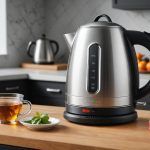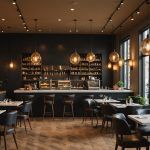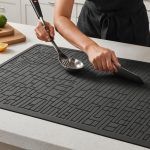Overview of Coastal Kitchen Flooring Needs
Choosing the appropriate kitchen flooring for coastal homes is vital due to the unique environmental conditions. Located near the sea, these homes encounter high humidity and salt-laden air, posing specific challenges. Moisture resistance should be the primary concern when selecting flooring in these areas. Such conditions can lead to warping or damage if unsuitable materials are used.
Coastal kitchens present further challenges arising from their climate. Frequent exposure to moisture from the beach, coupled with the typical household spills, intensifies the need for resilient surfaces. Flooring options that can withstand these pressures while offering easy maintenance are essential for long-term durability.
Also to read : Maximize your savings: the ultimate guide to snagging the best uk kitchen gadgets in seasonal sales
In addition to practical considerations, aesthetics play a significant role. Flooring in coastal homes often reflects the relaxed and airy vibe of the sea, with light and natural tones being popular choices. Flooring materials that complement coastal themes, such as neutral hues, weathered wood, or stone-like finishes, emphasize the design harmony within these captivating environments.
By thoughtfully selecting kitchen flooring that addresses both functional and aesthetic needs, homeowners can ensure their floors not only endure the coastal weather but also enhance the overall ambiance of their space.
In the same genre : Revamp your uk kitchen: the ultimate step-by-step guide to designing a chic and functional breakfast bar
Factors to Consider When Choosing Kitchen Flooring
When evaluating flooring options for coastal kitchens, several key factors to consider exist. The climate impact, specifically coastal humidity and salt air, can significantly affect flooring materials. Selecting materials that mitigate these environmental stresses is essential to ensure longevity and performance.
Proper installation and substrate preparation are crucial in coastal settings. The most expert recommendations stress ensuring that the floor’s foundation is robust and moisture barriers are adequately installed. This step can prevent potential damage caused by humidity seeping through the surface.
Insights from flooring experts emphasize the importance of choosing materials known for water resistance, such as high-quality tile and specific luxury vinyl products, as these can provide enhanced durability in damp conditions.
Additionally, aesthetics should not be neglected. Aligning flooring options with the overall design of the home and selecting colors that complement a coastal theme can enhance the kitchen’s appeal. By carefully considering these elements, homeowners can make informed decisions that contribute to the beauty and functionality of their coastal kitchens.
Popular Flooring Options for Coastal Kitchens
Selecting appropriate flooring options is crucial for coastal kitchens owing to their unique environmental demands. Understanding the range of materials available allows homeowners to match style with essential functionality.
Tile Flooring
Tile is a favoured choice for coastal homes due to its high durability and water resistance. It withstands moisture effectively, ensuring longevity in damp conditions. Versatile in design, tiles can mimic natural stone or present sleek, modern aesthetics, allowing seamless integration with coastal themes. It’s important to implement a routine cleaning schedule to maintain its lustre and performance over time.
Laminate Flooring
Laminate flooring offers a cost-effective alternative, prized for its easy installation. This flooring option can mimic the appearance of wood or stone, providing a vast array of design choices. However, while laminate can endure humid environments when properly sealed, it’s essential to consider that prolonged moisture exposure might limit its lifespan compared to other materials.
Vinyl Flooring
Luxury vinyl flooring stands out for coastal kitchens due to its superior water resistance and straightforward maintenance. Available in numerous styles, including those that replicate wood or stone, vinyl aligns with coastal aesthetics perfectly. Its ease of cleaning makes it a reliable choice for those seeking practical yet stylish solutions.
Wood Flooring
In coastal kitchens, wood flooring provides a distinct charm, but selecting the right type is essential due to the challenging moist environment. Hardwoods like teak and oak excel in these conditions, thanks to their natural sturdiness and resilience to humidity. These wood types feature tight grains and natural oils that afford some innate protection against moisture.
However, it’s critical to acknowledge the potential challenges associated with wood flooring in coastal homes. Moist atmospheres can lead to expansion, warping, or even degradation over time if not closely managed. Proper sealing and maintenance become vital, necessitating regular protective treatments to maintain durability and appearance.
When it comes to design, wood can enrich the coastal themes with its organic aesthetics. Its warm tones and textures offer a classic complement to the surrounding environment, creating an inviting and harmonious space. Options such as distressed finishes or whitewashes add a rustic, seaside vibe that enhances the overall aesthetic appeal. While wood requires more intensive upkeep, its unique charm, when paired with thoughtful maintenance practices, makes it a compelling choice for those wishing to incorporate a traditional yet stylish element into their coastal kitchens.
Maintenance Tips for Coastal Kitchen Flooring
Ensuring flooring longevity in coastal environments requires meticulous care. Given the unique challenges posed by these settings, understanding effective maintenance strategies is crucial. Regularly employing proper cleaning techniques can significantly improve the lifespan of your flooring.
To maintain coastal kitchen flooring, commence with choosing cleaning products that are explicitly formulated for the type of material installed. For instance, using a pH-neutral cleaner can prevent damage to tile and vinyl surfaces, while a specially formulated wood cleaner ensures that natural floors retain their shine without excess moisture exposure.
Developing a routine that includes prompt spill cleanup and weekly sweeping or vacuuming prevents debris from causing wear. Employing mats at entry points can trap sand and moisture, safeguarding the flooring beneath. Additionally, using dehumidifiers can mitigate the adverse effects of coastal humidity, thereby reducing the risk of warping.
Regular maintenance practices are indispensable in counteracting the challenges of salt air and moisture. Protective treatments, such as sealing wood floors periodically, ensure they remain robust amidst varying humidity levels. By implementing these strategies, homeowners can protect and prolong the life of their valued kitchen flooring.











